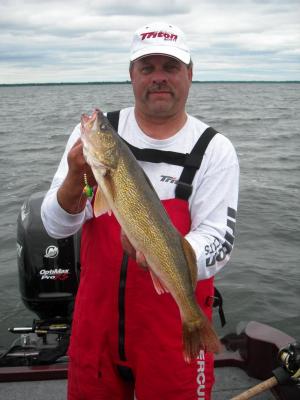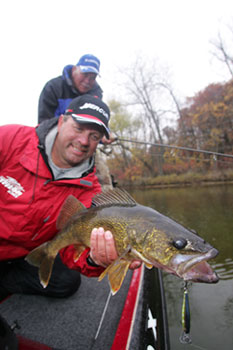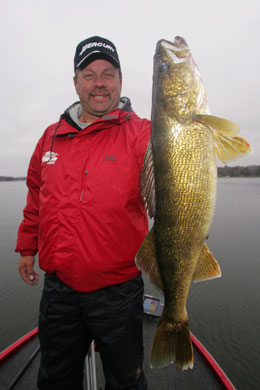 Summer vacation is over. It’s time for young anglers to go back to school.
Summer vacation is over. It’s time for young anglers to go back to school.
September is a great month for veteran walleye anglers to learn a thing or two, as well. The aquatic world is in transition as the days become shorter, water temperatures begin a slow cool and some bodies of water experience a fall “turnover” when oxygen is disbursed throughout the water column and a walleye’s comfort zone expands infinitely.
Like those attentive youngsters eager for a thorough education, anglers can enhance their skills in subjects ranging from reading and arithmatic to biology and physics. The road to higher education begins with a basic back-to-school checklist.
What classes do we need to take this semester?
With walleyes beginning to change from their summer behavior to their autumn existence, we need to call on our knowledge of biology, psychology and history, which tell us that these fish are on the move, motivated by food and the need to store reserves for the coming winter, aggressive and likely to turn up in locations where we’ve found them during previous Septembers.
How will we get to school?
We will need to travel across miles of water that can be gentle and inviting one minute but cantankerous and imposing the next. A large, rock-solid boat like my Mercury-powered Triton 215X carries me and my classmates comfortably and securely wherever we need to go.
Where can we find our classrooms?
Since we know that both baitfish and walleyes are in transition, the geography department is a good place to start. We need to find travel routes that offer the features walleyes covet, like bottom contour consisting of rock, rubble or clay, as well as a variety of depths for feeding, resting and cruising. Two prime locations are flats or shelves extending out from the shore or near river mouths that fall sharply into 10- to 20-foot depths and main-lake points that offer similar characteristics.
Today’s detailed mapping makes it easy to identify these locations. My Humminbird 1197 sonar/GPS unit is preloaded with extensive maps, and Navionics offers updated premium chips that provide even more information for many bodies of water.
What do we need for supplies?
 We’re looking for scattered pods of fish, so the best way to target them is by covering water. That means trolling those breaklines and points with crankbaits. Lead-core line excels in these situations. It allows us to get lures to the bottom without letting out miles of line and it keeps them in the strike zone when we’re making adjustments to follow an irregular contour line.
We’re looking for scattered pods of fish, so the best way to target them is by covering water. That means trolling those breaklines and points with crankbaits. Lead-core line excels in these situations. It allows us to get lures to the bottom without letting out miles of line and it keeps them in the strike zone when we’re making adjustments to follow an irregular contour line.
I use a 10-foot leader of Suffix braided line before the lead-core to enhance the action of my crankbaits, and I use 18-pound test lead-core. The diameter of the lead is the same as it is with 45-pound test lead-core. The difference is the amount of dacron wrapping, and I can get more feet of lead-core on a reel by using the smaller test. It’s also easier to fish because it comes off the reel and through the guides of the rod more smoothly.
Line-counter reels help duplicate success. If we know exactly how much line is out on a set-up that catches a fish, we can match it precisely on other rods.
My basic layout consists of two 10-foot rods fished at mid-ship and two five-footers fished from the stern. The difference in length usually provides enough distance between the lures to keep them from tangling, although debris can foul a lure and send it weaving out of control and into another line.
Fortunately, there doesn’t tend to be as much junk on the bottom in the fall as there is earlier in the open-water season, and it’s easy to tell when a crankbait picks up a leaf or a twig by watching the vibration of the rod tip. Most of the time, an aggressive forward sweep of the rod will dislodge the debris.
Some shallower situations call for a mix of lead-core and monofilament. When targeting part of a breakline or point less than about 12 feet deep, use mono on the long rods and let out more line to achieve the desired depth while using lead-core on the short rods to keep those lures closer to the boat.
What’s on the lunch menu?
The standard entree is aggressive crankbaits. Normark’s original Shad Raps and Rattling Suspended Shad Raps, along with Storm’s ThunderCranks, are among the best for these situations. They mimic many species of baitfish walleyes crave and they can attract fish from a distance with their vibration and flash.
Because we may be targeting different depths in a relatively narrow trolling path, a variety of crankbait sizes and presentations will help us fish with maximum efficiency. For example, we can use larger baits that dive quicker on our short rods to keep them close to the boat while employing smaller cranks that require more line on the longer rods to give us separation and help avoid tangles.
How do we earn extra credit?
 The best students are always prepared, pay close attention to detail and learn from their mistakes.
The best students are always prepared, pay close attention to detail and learn from their mistakes.
Tune your crankbaits before you put them to work. With about six feet of line out, drop them in the water and give them an aggressive pull alongside the boat. If they veer right or left, adjust the eye on the lure slightly in that direction until they run straight. This is important for two reasons – it keeps lures in tight proximity from tangling and it keeps them tracking straight when their speed changes as the boat turns.
Take note of your trolling speed. With aggressive, well-tuned cranks, 2.5 mph is a good starting point, but you may have to adjust to the mood of the fish on a particular day. Sometimes they may want a slightly slower-moving lure. Other times, you may have to increase the speed to as much as 3.5 mph.
Allow your lures to dig into the bottom on occasion. A crankbait that stirs up the substrate now and then resembles many forage species walleyes prefer and can help get their attention. It also lets you know that your lure is running exactly at the depth you want it.
Study your electronics. I always have one eye on my Humminbird so I can maintain consistent depth and follow contour with precision. When I catch a fish, I am quick to note any subtle changes that may have factored into that hook-up, such as an inside or outside bend in the contour, a hump or bump on the bottom or a transition where sand meets gravel, rubble becomes rock, etc. Not only will this help me reduce productive areas to specifics, it will allow me to duplicate the pattern at other locations on a body of water.
When I’m trolling a main-lake point, I travel beyond the end of the point so my lures work the depth I’m targeting as far as they can. Precision is paramount.
Passing the September test isn’t impossible. It’s a matter of drawing on the curriculum we’ve already studied, following the seasonal syllabus and supplementing it with new experiences. You just might school a limit of walleyes.










